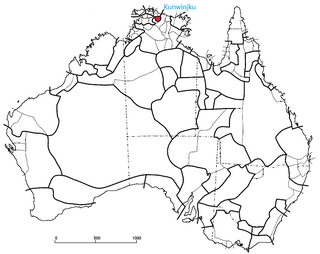
The Yolngu or Yolŋu are an aggregation of Aboriginal Australian people inhabiting north-eastern Arnhem Land in the Northern Territory of Australia. Yolngu means "person" in the Yolŋu languages. The terms Murngin, Wulamba, Yalnumata, Murrgin and Yulangor were formerly used by some anthropologists for the Yolngu.

William Lloyd Warner was a pioneering anthropologist and sociologist noted for applying the techniques of British functionalism to understanding American culture.
The Pintupi are an Australian Aboriginal group who are part of the Western Desert cultural group and whose traditional land is in the area west of Lake Macdonald and Lake Mackay in Western Australia. These people moved into the Aboriginal communities of Papunya and Haasts Bluff in the west of the Northern Territory in the 1940s–1980s. The last Pintupi to leave their traditional lifestyle in the desert, in 1984, are a group known as the Pintupi Nine, also sometimes called the "lost tribe".
Lester Richard Hiatt, known as Les Hiatt, was a scholar of Australian Aboriginal societies who promoted Australian Aboriginal studies within both the academic world and within the wider public for almost 50 years. He is now regarded as one of Australia's foremost anthropologists.
The Burarra people, also referred to as the Gidjingali, are an Aboriginal Australian people in and around Maningrida, in the heart of Arnhem Land in the Northern Territory. Opinions have differed as to whether the two names represent different tribal realities, with the Gidjingali treated as the same as, or as a subgroup of the Burarra, or as an independent tribal grouping. For the purposes of this encyclopedia, the two are registered differently, though the ethnographic materials on both may overlap with each other.

The Kunwinjku people are an Australian Aboriginal people, one of several groups within the Bininj people, who live around West Arnhem Land to the east of Darwin, Northern Territory. Kunwinjku people generally refer to themselves as "Bininj" in much the same way that Yolŋu people refer to themselves as "Yolŋu".
The Gunavidji people, also written Kunibidji and Kunibídji and also known as the Ndjébbana, are an Aboriginal Australian people of Arnhem Land in the Northern Territory.
The Goeng or Gureng were an Aboriginal Australian people of the state of Queensland. They lived in the area of the area of present-day Gladstone.
The Djinang are an Aboriginal Australian people of the Northern Territory.
The Yan-nhaŋu, also known as the Nango, are an indigenous Australian people of the Northern Territory. They have strong sociocultural connections with their neighbours, the Burarra, on the Australian mainland.
Ian Keen is an Australian anthropologist, whose research interests cover Yolngu kinship structures and religion, Aboriginal land rights and economies, and language.
The Gadjalivia were an indigenous Australian people of Arnhem Land in the Northern Territory. They are now regarded as extinct.
The Ritharrngu and also known as the Diakui, are an Aboriginal Australian people of Arnhem Land in the Northern Territory, of the Yolŋu group of peoples. Their clans are Wagilak and Manggura, and Ritharrŋu.
The Dalabon or Dangbon are an Australian Aboriginal people of the Northern Territory.
The Tjial were an indigenous Australian people of the Northern Territory who are now extinct.
The Alura are an Aboriginal Australian people of the Northern Territory.
The Daii or Dhay'yi are an indigenous Australian people of the Northern Territory.
The Jingili or Jingulu are an indigenous Australian people of the Northern Territory.
The Mudburra, also spelt Mudbara and other variants, are an Aboriginal Australian people of the Northern Territory.
The Perrakee are assumed to have been an indigenous Australian tribe, now extinct.